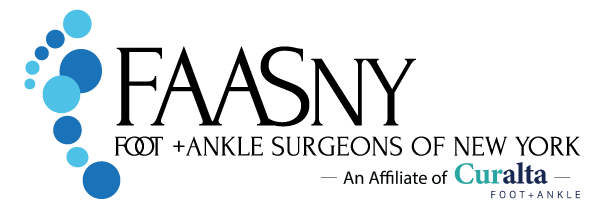Bunion Surgery New York

Dr. De Lucia completed his training at the New York Hospital Medical Center of Queens after graduation from New York University and the New York College of Podiatric Medicine. He is dual Board Certified by the American Board of Foot and Ankle Surgery and the American Board of Podiatric Medicine.
Dr. De Lucia is a proud alumnus of Archbishop Molloy High School. Thereafter, he completed his undergraduate education at New York University in the College of Arts and Science with a degree in Psychology while on the Pre-Med track, and his medical degree in Podiatric Medicine and Surgery at the New York College of Podiatric Medicine.
After both his undergraduate and medical school education, Dr. De Lucia’s training continued with an advanced Podiatric Medical and Surgical Residency at hospitals such as: North Shore University Hospitals (Forest Hills, Manhasset, & Southside Hospital), Wyckoff Heights Medical Center, South Nassau Communities Hospital and the New York Hospital Medical Center of Queens.
His medical and surgical training consists of four years of advanced specialization in the medical and surgical care of conditions affecting the lower leg, ankle and foot, with a residency foundation based on an appreciation and applications of general medicine.
Throughout his training, as well as currently, Dr. De Lucia participates in continuing medical education in several areas of foot and ankle surgery including external ring fixation, limb salvage, reconstructive surgery of the lower extremity, pediatric foot and ankle surgery, biomechanics, lower extremity trauma, joint replacement surgery, internal fixation, arthroscopic surgery and microsurgery.
Dr. De Lucia is a Fellow of the American College of Foot & Ankle Surgeons and a Diplomate of the American Board of Podiatric Medicine.
He is a proud member of the American Podiatric Medical Association (APMA), and New York State Podiatric Medical Association (NYSPMA).
Dr. De Lucia has served as the New York State Chapter President of the APMA Young Physician’s Division, as well as a Past-President of the Queens County Division for the New York State Podiatric Medical Association.
Dr. De Lucia is an Honorary Police Surgeon of the New York City Police Department (NYPD), as well as a Police Surgeon of the New York State Fraternal Order of Police and the New York State Trooper’s Benevolent Association, as well as the Amtrak Police FOP.
His interests extend to all areas of podiatric care, both medical and surgical for all ages of patients who require comprehensive and specialized care of the foot and ankle. His areas of particular interest are lower leg, foot and ankle trauma surgery, reconstructive surgery of congenital deformity, as well as adult and pediatric flatfoot reconstruction.
Dr. De Lucia is fluent in Italian and conversant in Spanish.
He holds hospital and medical facility appointments at the New York Presbyterian Queens Medical Center, Northwell Health System hospitals such as: North Shore University Hospitals of Forest Hills and Manhasset, Long Island Jewish Medical Center, LIJ Valley Stream Hospital, Southside Hospital, Lenox Hill Hospital and NYU-Winthrop University Hospital.
About FAASNY
Our practice philosophy is to examine patients on the whole rather than simply from the ankle downward. Many diseases first present themselves in the lower extremities, just as they may also in the later stages. A specialist, therefore, must always be able to think like a generalist…while still being a specialist. We are a group of professional, empathic and interested practitioners who specialize in all conditions of the lower extremity within an inviting and brand new state of the art office setting. Our office staff is cheerful, up to date and eager to assist you in all of your needs outside of the exam room.
Since the very early days of our training, each of us has discovered the love for our profession and the absolute art that medicine and surgery can, and should always be.
We thank you in advance for your consideration in providing us with the absolute privilege of treating your conditions.

Recent Blog Posts
Metatarsal Foot Surgery

Knowing you’re on the verge of a surgical procedure can undoubtedly take a toll on your mental stress, but the potential long-term relief for a constant problem is too ideal to pass up. Several patients are wary of surgery because they’re aware of the elongated recovery process. But if you’ve taken the necessary preparations before hopping on the operating chair, your recovery process could be expedited. For example, metatarsal surgery treats the weight bearing portions on a person’s foot. At Foot And Ankle Surgeons Of New York, the best podiatrist on Long Island, we are trained to treat several foot-related complications you have been experiencing. After undergoing an evaluation, your doctor may recommend this procedure for your discomfort.
Structurally, the metatarsal is composed of five bones in the foot. You can find them behind each toe, as they are the long bones in the foot. Typically, metatarsal surgery is recommended for the treatment of the following conditions:
- Bunion Deformity
- Tailor’s Bunion Deformity
- Painful Calluses (Found on the bottom of the foot)
- Ulcerations (that have not been healing)
- Fractures
- Rheumatoid Arthritis
The Operation
Depending upon which complication you’re dealing with, different methods could be utilized for metatarsal foot surgery. For example, calluses that are causing pain will need to be removed in conjunction with the operation. Essentially, the procedure involves the cutting of the metatarsal bone itself. During this process, the bone can be sliced all the way through; then it is elevated and held into its correct position through the assistance of a device (metal pin or screw). Patients will need to wait for a decent amount of time before your surgeon can remove the pin. Pressure will need to be withheld from the foot, likely through the assistance of crutches and other devices. Once this process is completed, your surgeon can remove the pin in a follow-up visit and the recovery stages will begin to take place.
Before Surgery
Before the operation, patients may look to visit a physical therapist. This will give them the opportunity to learn about the equipment they may need to use after surgery and can improve strength in the foot. It’s also recommended that patients abstain from eating or chewing gum after midnight on the day of their operation. This is an essential step because the anesthesia will likely not work as effectively on a full stomach.
The Day of Surgery
Patients should arrive at the hospital wearing baggy, comfortable clothes. The foot and leg should be easily accessible, so no elastic on the bottom of the pants would be preferred. At Foot And Ankle Surgeons Of New York, the best podiatrist on Long Island, we ensure all of our clients are entirely comfortable with the procedures going to take place on the day of surgery.
After The Surgery
The days following your metatarsal surgery you might experience some uncomfortable symptoms such as swelling, bruising, leakage, and fevers. Although these might be alarming to experience, they are entirely normal. Depending on the severity of the operation, you will have to make accommodations to the foot that was operated on. Keeping pressure off of the recently operated area is crucial for a quick and full healing process.
If you’re considering a metatarsal surgery, you’ll want to visit a foot and ankle surgeon that is trusted and well experienced. Foot And Ankle Surgeons Of New York is made up of the best podiatrist on Long Island that has well-trained specialists working for their team. Please contact them today if you’re searching for relief of any foot/ankle problems you are experiencing.
Preparing For Foot Surgery

Patients that require orthopedic surgery on their feet have a multitude of different needs for their specific condition. The initial degree of preparation for your surgery likely depends upon the severity of the issue at hand. Yet, there exist general guidelines that anyone who is about to undergo foot surgery can benefit from. Ensuring that you are fully prepared for the surgery itself, along with your daily life after the surgery, is crucial in promoting a healthy recovery process. If you are looking for the best podiatrist on Long Island, Foot and Ankle Surgeons of New York are here to provide your orthopedic needs.
Preparing Around The House
If you live alone, you will need to prepare your home to be more accessible for yourself while you recover from surgery. If your bedroom is upstairs, consider making a bed on the main floor of your home, and gather everything else you may need. Doing so will allow you to minimize your efforts moving around while allowing you to engage in optimal rest time. You’ll also want to fill your home with all the essential items that you may require after foot surgery.
Remember, you’ll want to prevent yourself from having to leave the house as much as possible. It’s also imperative that you make premeditated plans for meals. Try having them ready to heat up so that you will not have to stand and cook for a prolonged period. Make sure that you have all necessary items at your close reach, limiting the number of times that you will be forced to stand up on your feet.
Dressing After Surgery
For dressing yourself after foot surgery, you’ll want to prepare soft, loose clothing that is easy to take on and off. Aggravating your foot by dressing and undressing and can be a frustrating occurrence. Look to wear suitable clothing such as sweatpants for the next couple of weeks. It is also best to have a few changes of clothes right at your disposal so that you will not have to travel far. At FAASNY, the best podiatrist on Long Island will help you to be as comfortable as possible after surgery.
Avoid Driving After Surgery
After foot surgery, you’ll need to arrange for someone to pick you up to take you home as you will be unable to drive during recovery. Should the need arise for you to leave the house, have someone take you to your destination. It is discouraged to be in a car a week or two after surgery because you will be unable to elevate your foot above heart level as properly instructed.
What To Expect The Day Of The Surgery
On the day of the foot surgery, you should have all nail polish or jewelry removed and remember to wear loose, comfortable clothing. Make sure to arrive early, about two hours, to allow an ample amount of time to fill out forms and make other preparations. Your doctor will administer anesthesia before the surgery, and make sure you are comfortable before beginning. The length of the surgery will depend on what exactly is being treated.
Best Podiatrist on Long Island
When you are undergoing foot surgery, you want to make sure you are being treated by the best of the best. If you are seeking a podiatrist on Long Island, FAASNY can help. We have very experienced and knowledgeable doctors that will ensure you are treated with the utmost care. Contact us today if you want to be treated by a podiatrist on Long Island!
Assessing Your Foot/Ankle Deformity

There are many deformities that can develop in the lower extremities of the human body. More specifically, these deformities can be seen in the ankle or foot. People with foot or ankle deformities may have symptoms such as pain, tenderness, swelling, bruising, stiffness in the joint, and/or difficulty walking. These symptoms can vary, depending upon which ailment you’re dealing with. Because each foot/ankle deformity is so different, you will need a professional to assist you in the evaluation of your deformity. Luckily, Foot and Ankle Surgeons of New York, also known as FAASNY, provide treatments for numerous conditions and deformities pertaining to the lower extremities. Contact their office to reach the best podiatrist on Long Island.
The best Podiatrist on Long Island has doctors that are extensively trained in the diagnoses and treatments of deformities in the foot or ankle. Examples of these deformities can include but are not limited to the following:
- Achilles Tendon Disorder- This disorder can be stimulated by constant stress on the Achilles’ tendon which connects the calf muscle to the heel bone.
- Brachymetatarsia– A condition where one of the bones in the foot is abnormally shorter than the others, leading to the deformed appearance.
- Bunion (Hallux Abducto Valgus)- A bulge on the side of the big toe in which the bones are misaligned. Bunions are typically inherited and can be an uncomfortable annoyance.
- Flat Feet (Adult and Children)- This is an ongoing collapsing of the arch of the foot that can occur in both adult and children.
- Gout- A disorder that occurs from too much uric-acid developing in the tissues or any of the joints.
- Haglund’s Deformity– An abnormality that may present itself as a bump on the back of the heel bone.
Once done assessing and diagnosing your foot/ankle deformity, the best podiatrist on Long Island can provide treatments for corrective measures. The treatment process will differ depending on the diagnoses. If non-surgical treatment options have shown to be ineffective, surgery may be the best method for moving forward. Foot and Ankle Surgeons of New York are specialized in adult and pediatric lower extremity surgery.
Get the full assistance you need in assessing your foot/ankle deformity by contacting and booking an appointment with FAASNY.
Does Wearing High Heels Harm Your Feet?

Have you experienced foot discomfort from wearing high heels? That is because these shoes could be causing damage to the structures of your foot!
It has been proven by the American Podiatric Medical Association that, yes indeed, those super-cute high heels can be causing a lot of harm and wreak havoc on your feet. Whether they’re stiletto or mid-sized pumps, any high heeled shoe can potentially lead to short-term or chronic problems.
- One of the main issues that can arise from wearing those high heels of yours is the “Pump Bump” or deformity that occurs on the back of the heel when pressed against your shoe for too long. This can cause blisters, pain in the Achilles tendon, swelling, and bursitis to occur. In some cases, this bony protrusion can even become permanent.
- Another way your high heels can be affecting your feet is the unnatural arch position. By forcing yourself into this pose for an extended period, it can be causing an extreme amount of stress on the balls of your feet. This constant pressure can lead to serious issues such as hairline fractures to occur.
- Lastly, one of the most common problems people face while wearing those dreaded high heels is ankle sprains. Any high heel can increase your chances of an ankle sprain to happen. This lateral sprain occurs when the outside of your foot rolls out of its natural position, therefore stretching the ligaments beyond their normal reach. A severe ankle sprain can happen, even risking torn ligaments and other potential damage.
If you do opt to wear those heels next time you go out, here are some ways in which you can help alleviate the pain and stress on your feet:
- Make sure you’re wearing the proper sized heels for your foot.
- Wear a thicker heel for added stability.
- Try to reduce the amount of time spent wearing heels.
- Get custom orthotics from one of our specialists for added support and comfort.
It’s never too late to do something about your foot pain! Contact us today to schedule an appointment with one of our specialists here at Foot and Ankle Surgeons of New York.
Frequently Asked Questions about Podiatrists:
Can a podiatrist do surgery?
A podiatrist does have the ability to do surgery, as well as reset any broken bones, prescribe medication, and order or conduct lab tests or x-rays.
What are the common conditions treated by a podiatrist?
A podiatrist is a healthcare professional that deals mainly with the feet and lower limbs. They have the ability to diagnose and treat related conditions, as well as prevent or correct any deformities. They can help relieve you of pain in these areas, treat infection, or even help with mobility.
When should you visit a podiatrist?
You should schedule an appointment with a podiatrist if any of the following pertain to you. You have persistent swelling or pain in your foot or lower limbs that have not reduced or gone away with two to five days. You often experience a burning, numbing, or tingling feeling at the bottom of your foot.

